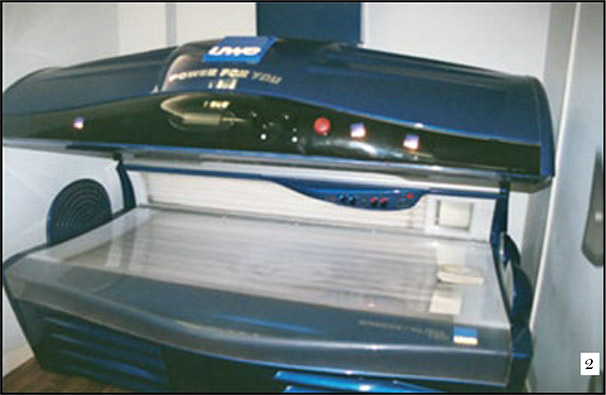Tanning beds: myths and reality.
Keywords:
tanning beds, indoor tanning, sunbeds, ultra violet radiation, malignant melanomaAbstract
The deleterious effects of solar radiation on human skin are thoroughly understood; however, the use of tanning beds with cosmetic purposes has extended throughout the world. It is estimated that 30 million people use them, and 2.3 million of those are teen agers. This business made 5 billion dollars in 2005, 13 million a year in the United States. Approximately one million people are thought to get a tan each day, 70% of which are white females between 16 and 49. The first tanning beds at the beginning of the 70´s used broad spectrum UVR; in the 80´s, these lights 95-98% UVA. Recently, high pressure lamps, with crescent doses of UVB have become widely used.
There are several myths about tanning booths, like 1) tanning is healthy, 2) they do it for medical reasons, like vitamin D synthesis and disease control, like psoriasis, 3) that it protects from sun damage, and 4) that they are less damaging then the sun.
The truth is artificial tanning is not a healthy practice; on the contrary, UVR has been recognized by the World Health Organization as a carcinogenic agent like cigarettes or X rays, reaching the conclusion that sunbeds are not safe.
Its use has not been well controlled in many countries including Colombia and even where there are well established norms, these are not followed, because it is been proven that doses greater then a sunny day have been given. This is not only way higher than the doses needed to synthesize vitamin D, but can also increase its metabolism. For all these reasons, from the medical point of view, there is no justifying for the use of tanning beds.
Author Biography
Ángela Zuluaga
Médica dermatóloga, Universidad de Antioquia; profesora titular, Universidad CES; dermatóloga, Clínica Las Vegas, Medellín, Colombia.
References
2. Levine JA, Sorace M, Spencer J, Siegel DM. The indoor UV tanning industry: a review of skin cancer risk, health benefit claims, and regulation. J Am Acad Dermatol. 2005;53:1038-44.
3. Robinson JK, Kim J, Rosenbaun S, Ortiz S. Indoor tanning knowledge, attitudes and behavior among young adults from 1988-2007. Arch Dermatol. 2008;144:484-8.
4. Gerber B, Mathys P, Moser M, Bressoud D, Braun-Fahrlander CS. Ultraviolet emission spectra of sunbeds. Photochem Photobiol. 2002;76:664-8.
5. Oliver H, Ferguson J, Moseley H. Quantitative risk assessment of sun beds: impact of new power lamp. Br J Dermatol. 2007;157:350-6.
6. Feldman SR, Liguori A, Kusenic M, Rapp SR, Fleischer AB, Lang W, et al. Ultraviolet exposure is a reinforcing stimulus in frequent indoor tanners. J Am Acad Dermatol. 2004;51:45-51.
7. O'Riordan DL, Field AE, Geller AC, Brooks DR, Aweh G, Colditz A, et al. Frequent tanning bed use, weight concerns and other health risk behaviors in adolescent females (United States). Cancer Causes Control. 2006;17:679-86.
8. Yetntzer BA, Feldman SR. Tanning beds as an alternative for psoriasis when office-based phototherapy is not accessible. J Dermatol Treat. 2008;8:1-3.
9. Ruegemer J, Shuetz B, Hermann K, Hein R, Ring J, Abeck D. UV-induced skin changes due to regular use of commercial sunbeds. Photodermatol Photoimmunol Photomed. 2002;18:223-7.
10. Whitmore SE, Morison WL, Potten CS, Chadwick C. Tanning salon exposure and molecular alterations. J Am Acad Dermatol. 2001;44:775-80.
11. Young AR, Potten CS, Nikaido O, Parsons PG, Boenders J, Ramsden JM, et al. Human melanocytes and keratinocytes exponed to UVB or UVA in vivo show comparable levels of thymina Diners. J Invest Dermatol. 1998:111:936-40.
12. Diffey BL. A quantitative estimate of melanoma mortality from ultraviolet A sunbed use in the U.K. Br J Dermatol. 2003:149:578-81.
13. Hornung R.L, Magee K.H, Lee W.J, Hansen L and Hsieh Y-C. Tanning facility use: Are we exceeding Food and Drug Administration limits. J Am Acad Dermatol 2003;49:655-61.
14. Aalborg J, Morelli JG, Mokrohisky T, Asdigian L, Byes TE, Dellavalle RR, et al. Tanning and increased nevus development in very-light-skinned children without red hair. Arc Dermatol. 2009;145:989-96.
15. The International Agency for Research on Cancer Working Group on artificial ultraviolet (UV) light and skin cancer. The association of use of sunbeds with cutaneous malignant melanoma and other skin cancers: A systematic review. Int J Cancer. 2006;120:1116-22,
16. Bataille V, Boniol M, De Vries E, Severi G, Brandberg Y, Sasieni P, et al. A multicentre epidemiological study on sunbed use and cutaneous melanoma in Europe. Eur J Cancer. 2005;41:2141-9.
17. Boyd AS, Shyr Y, King LE. Basal cell carcinoma in young woman: An evaluation of the association of tanning bed use and smoking. J Am Acad Dermatol. 2002;46:706-9.
18. Mayer JA, Hoerster KD, Pichon LC, Rubio DA, Woodruff SI, Forster JL. Enforcement of state Indoor tanning laws in the United States. Prev Chronic Dis. 2008;5:1-10
19. Sinclaire C. Artificial tanning sunbeds: risks and guidance. World Health Organization 2003. http//www.who.int/uv/ publications/sunbedspubl/en/
20. Masintosh K 2006. The regulation of sunbed palours Bill. (Scotland) www.kenmacintoshmsp.co.uk
21. Special report: Policy. A review of human carcinogens. Part D: radiation. Lancet. 2009;10:751-2.
22. Pichon LC, Mayer JA, Hoerster KD, Woodruff JI, Slymen DJ, Belch GE, et al. Youth access to artificial UV radiation exposure. Arch Dermatol. 2009;145:997-2002.
How to Cite
Downloads

Downloads
Published
How to Cite
Issue
Section
| Article metrics | |
|---|---|
| Abstract views | |
| Galley vies | |
| PDF Views | |
| HTML views | |
| Other views | |






